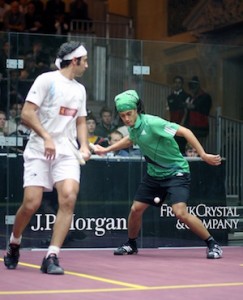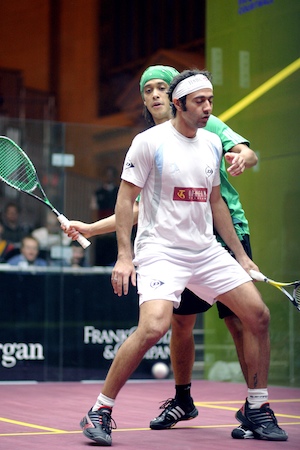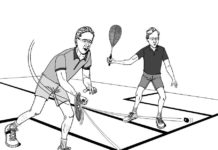By Barry Faguy, WSF Referees and Rules Committee
It’s not an exaggeration to say that there would be little continuity in a game if not for the goodwill of the striker. When you’ve got two quick people running around in only 672 square feet of space, swinging long rackets and chasing after a fast moving ball—interference is a given.

There will be every degree of interference on the scale—and some strikers will play through just about everything, busting a gut to play the ball—and others, well, not so much. Many find it irritating to see this latter type of player who calls a let at the smallest of interferences—looking to avoid a tough return, or to get a break because of fatigue.
Encouraging continuity
To encourage continuity, the rules put the onus on both players to “make every effort”—one to play the ball, and the other to clear it. This clearing part, however, is quite often more difficult to accomplish—which is why we have interference in the first place. So, in terms of continuity, it’s left mostly to the striker to decide to accept whatever interference exists—or not. How should you, as a Referee, encourage this demonstration of goodwill and have the striker accept some interference and play on?
You have two weapons
* Every effort: (Rule 12.7.2) This well-known phrase has been in the rules forever, and although those two words might be unrealistic, they get the message across. The message is that one should try pretty darn hard—short of physical abuse of course. Those words draw the Referee’s attention to the amount of effort that the striker is making—and if it’s inadequate, according to a given Referee’s standard, then a No Let is the decision.
A caveat: With fairness as the guiding principle, the striker must not be forced into accepting so much interference that the return will be compromised. There is a limit as to what the Referee can demand.
* Minimal interference: (Rule 12.7.1) In contrast to the above, these two words direct the Referee’s attention to the interference itself. If it’s determined to be “minimal”—once again we have a No Let.

A caveat: It’s key to understand that “minimal” is meant to apply to the “effect” that the interference had—not the actual “amount” of interference. A striker can often scramble around an opponent—accepting 1, 2, or 3 feet of actual interference—but the simple one-inch stubbing of a shoe can cause a player to fall. That is the key issue here; you need to notice the effect.
Thus, the approach by each weapon is different—one calling on the Referee to identify a shortcoming of effort, the other, perhaps easier, to identify an insignificant interference. Using the two in concert helps you, as Referee, to form a better picture of what happened and make the fair decision.
Be careful with “minimal”
1. Watch for exaggerations: Without being too cynical, be alert for strikers who might be playing up the effect in order to avoid having that minor interference characterized as “minimal”—and be alert for non-strikers attempting to use this rule to try to get away with making less effort to clear—a classic blocking technique.
2. It’s not for the swing: This “minimal interference” concept (which mandates a No Let) has its application for two forms of interference—the view, and the access—not for the swing. The simple reason is the great sensitivity of the swing movement to virtually any deflection—as we outlined in last month’s article.
MEANWHILE: If you want information on just about any officiating topic, go to (www.squash.ca/e/officiating/tso/) and click on the “Library” link to the left to find your subject.





